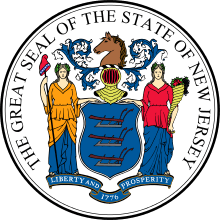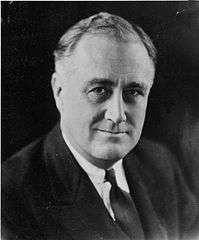United States presidential election in New Jersey, 1932
| | ||||||||||||||||||||||||||||||||
| ||||||||||||||||||||||||||||||||
| ||||||||||||||||||||||||||||||||
|
| ||||||||||||||||||||||||||||||||
| County Results
Roosevelt—70-80%
Roosevelt—50-60%
Roosevelt—<50%
Hoover—50-60% | ||||||||||||||||||||||||||||||||
| ||||||||||||||||||||||||||||||||
The 1932 United States presidential election in New Jersey took place on November 8, 1932. All contemporary 48 states, were part of the 1932 United States presidential election. New Jersey voters chose 16 electors to the Electoral College, which selected the President and Vice President.
New Jersey was won by the Democratic nominees, Governor Franklin D. Roosevelt of New York and his running mate Speaker of the House John Nance Garner of Texas. Roosevelt and Garner defeated the Republican nominees, incumbent Republican President Herbert Hoover of California and incumbent Vice President Charles Curtis of Kansas.
Roosevelt narrowly carried New Jersey with a plurality of 49.48% of the vote to Hoover's 47.59%, a victory margin of 1.90%. [1]
Socialist Party candidate Norman Thomas finished in third in New Jersey with 2.64%, more than the 2.23% he received nationally. Reflecting a nationwide left-wing backlash against the conservative policies that had been perceived to have culminated in the Great Depression in 1929, Thomas in 1932 received more than 8 times the 0.32% of the vote he had received in New Jersey in 1928. Combined together, socialist parties in New Jersey received 2.89% of the vote in New Jersey in 1932, nearly seven times the 0.43% they had received altogether in the state in 1928.
This left-wing backlash was also evident in Roosevelt's own victory in the state. His 1932 victory, although narrow, represented a nearly 22 point swing in favor of the Democratic Party from the results of 1928, in a state that had long been a Republican stronghold. In 1920 and 1924, the state had voted over 68% and over 62% Republican, respectively, with GOP victory margins over the Democrats of nearly 40 points.
On the county level map, reflecting the closeness of the race, Roosevelt managed to narrowly win the state despite carrying only 4 of the state's 21 counties.
The most important component to Roosevelt's victory was his overwhelming victory in heavily populated Hudson County, part of the New York City metro area, and populated by many urban ethnic immigrant communities. Like NYC, the county- along with the state as a whole- had begun trending Democratic in the 1928 election, when the Democrats had nominated Al Smith, a New York City native, and Roman Catholic of Irish, Italian and German immigrant heritage who appealed strongly to ethnic immigrant communities primarily concentrated in urban areas. While Smith in 1928 lost the state overall by a 59.77%-39.79% margin, this still represented a dramatic gain from just four years earlier: in 1924, southern Democrat John W. Davis had received only 27% of the vote in New Jersey. Besides Hudson County, Smith had also made dramatic Democratic gains in other urban parts of North Jersey, including Essex County, home to Newark, along with Middlesex County, Passaic County, Union County, Bergen County, and Mercer County.
But despite losing nationally in a 58-41 GOP landslide, Smith's Democratic gains in urban areas across America, laying the groundwork for a new urban Democratic coalition, were nowhere more evident than in the New York City metro area. After two Republican sweeps of all five boroughs of New York City in 1920 and 1924, Smith won a commanding victory in all five boroughs of NYC in 1928. In New Jersey this urban popularity in the New York City area spilled over into nearby Hudson County, New Jersey. Despite losing every other county in the state, many by large margins, Smith carried Hudson County with over 60% of the vote.
In 1932, with embattled incumbent Republican Herbert Hoover being perceived as failing to adequately address the Great Depression, many urban ethnic working-class voters swung even more strongly to the Democratic Party, and Franklin Roosevelt would receive over 70% of the vote in Hudson County, providing much of the raw vote margin by which he managed to eke out a narrow statewide win.
Besides his landslide win in Hudson County, FDR also won majorities in heavily populated Middlesex County and rural Warren County, and won a plurality in fairly populated Passaic County.
However Hoover kept the race close statewide by winning majorities in 17 of the state's 21 counties, although all of them by relatively close margins, failing to break 60% in a single county.
Overall, the Northeast was Roosevelt's weakest region in 1932, with all 6 of Hoover's state victories coming from this region in the midst of a nationwide Democratic landslide. However the overwhelming urban vote in FDR's favor in 1932 helped to narrowly tip New Jersey into the Democratic column, even as much of the state's geographic area remained Republican. A similar pattern was seen in neighboring New York State, which FDR won comfortably despite winning only 10 of the state's 62 counties, the overwhelming majority of his victory margin there being provided by landslide wins in the five boroughs of massively populated New York City.
Like most Northeastern states, New Jersey in the early decades of the 20th century had been a reliably Republican state; the state had not given a majority of the vote to a Democratic presidential candidate since 1892. (In 1912, Woodrow Wilson, then the sitting Governor of New Jersey, won the state's electoral votes, but with a plurality of only 41% in a 3-way race against a split Republican field, with former Republican President Theodore Roosevelt running as a third party candidate against incumbent Republican President William Howard Taft. Wilson lost the state to the GOP by a decisive 12-point margin in a head-to-head match-up in 1916.) The state's strong Republican lean was still evident in FDR's 1932 election campaign: although he narrowly won the state with a 49.5-47.6 plurality over Herbert Hoover, in the midst of his nationwide landslide, that still made the state almost 16% more Republican than the nation. By 1936, with the emergence of the New Deal Coalition, FDR would make dramatic gains for the Democratic Party in New Jersey that would endure and transform it into a closely divided swing state with only a slight Republican lean, a pattern that would endure for much of the 20th century until New Jersey ultimately became a solid Democratic state in the 1990s.
| Elections in New Jersey | ||||||||
|---|---|---|---|---|---|---|---|---|
 | ||||||||
|
||||||||
|
||||||||
Results
| United States presidential election in New Jersey, 1932 | |||||
|---|---|---|---|---|---|
| Party | Candidate | Votes | Percentage | Electoral votes | |
| Democratic | Franklin D. Roosevelt | 806,630 | 49.48% | 16 | |
| Republican | Herbert Hoover | 720,322 | 47.59% | 0 | |
| Socialist | Norman Thomas | 42,998 | 2.64% | 0 | |
| Communist | William Z. Foster | 2,915 | 0.18% | 0 | |
| Socialist Labor | Verne L. Reynolds | 1,062 | 0.07% | 0 | |
| National Prohibition | William Upshaw | 774 | 0.05% | 0 | |
| Totals | 1,630,063 | 100.0% | 16 | ||
See also
References
- ↑ "1932 Presidential General Election Results - New Jersey". Dave Leip's Atlas of U.S. Presidential Elections. Retrieved 20 January 2014.
Template:United States elections, 1932



